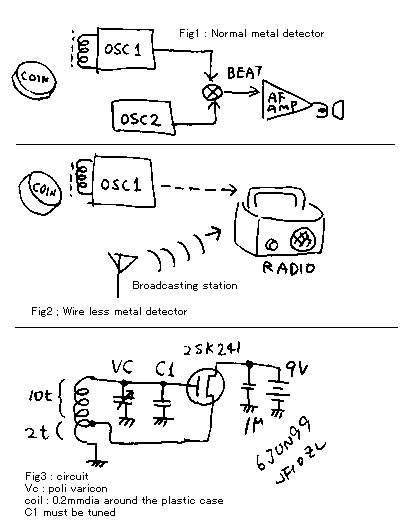Do you know what is a wireless metal detector? It is a gear to search a metal hidden under the ground. Do you remember the German soldier used it on the "COMBAT"? It was used to discover a land mine under the ground. It can be used to search a coin on the beach.
See Fig1! It is normal diagram of the metal detector. If the coin or some metal come to near from the coil of the first oscillator, the oscillated frequency of it is changed. The second Oscillator must have no influence of the metal. The product detector exchanges the difference of these two oscillators to the audio beat signal. This audio signal can be heard after the audio amplifier.
I had a new idea. See Fig2! If the frequency of the first oscillator is near from the broadcasting station, the change of the frequency of the detecting oscillator can be heard with the change of the beat with the oscillator and the broadcasting. See the Fig3! This is a circuit of this gear. Very simple! Coil and capacitor1 must be tuned to be the oscillating frequency of your neighboring broadcasting station. The result of this gear was as follows.
1. This gear can be detect the can and transformer. But this can not detect the coin and minus driver. Yes. Sensitivity was not so good.
2. The radio can not sound with beat. When the frequencies of the broadcasting station and this detector mach , the broadcasting signal is masked . The AGC of the radio receiver reduces the sensitivity of the radio, and broadcasting can not be heard. When the oscillating frequency of the metal detector changes some ten kiro hertz, this disturbance disappears and the broadcasting can be heard.
3. This system has the influence by the relative angle of the metal detector and the radio receiver. In order to use this detector, I must keep the relative angle of them. You will understand that is not so easy.
As I explained , this idea was not so useful. But I could enjoy to make and test it. Therefore I introduced it for you.
Dear Kazu - I enjoy your web page very much. I need to find a metal stake in the ground that held up my antenna mast, so I built a metal detector like your "wireless" circuit. I made 200 turns of wire on the end of a 3cm plastic pipe and made a Colpitts oscillator with 2200pf capacitors and 2N3904 transistor. This oscillated at 180 kHz. I did not use a circuit board - I just soldered the wires of the parts together and pushed them into the end of the pipe. I made a coupling loop with 5 turns around the pipe and taped it 20cm from the oscillator. This fed a coax cable which went to my receiver. I used a TS-450 with a large battery in a children's wagon, because it would tune to 180 kHz. Actually, the sensitivity was better when I tuned to a harmonic of the oscillator frequency, so I used the 9th harmonic at 1620 kHz. The result was similar to yours. I could detect a wrench at 2 cm distance. But I could not find the metal stake in the ground. (I want to remove it before we try to plant a garden in that place.) I think my next design will be a wheatstone bridge with two coils and two resistors. One resistor will be variable to balance the bridge. The output of the bridge will drive an amplifier (the LM386 is good to 300 kHz) and then a diode detector and audio VCO. I will use a variable resistor between the oscillator and the bridge for a sensitivity control. Maybe it will work. Maybe it will not work. Here is an idea for you: use an FM receiver IC for metal detector. IC like MC3357, MC3361, CA3089. (I'm sure there are many Japanese equivalents.) Many chips are designed to receive 10.7 MHz IF signal and convert it to 455 kHz, with limiting amplifier and quadrature demodulator. Quadrature detector works by detecting phase shift due to frequency change in input. To use as metal detector, use oscillator stage on the IC to make 455 kHz using sense coil. Bias mixer so signal passes into the limiting amp and to quadrature detector. Use 455 kHz ceramic resonator or LC circuit for quadrature coil. When output is on correct frequency, output from detector will be DC level which will change up or down when input frequency goes up or down. This can drive a meter or audio VCO to indicate result. I think that the oscillator could use a ceramic filter and the sense coil as part of the quadrature tuned circuit might work just as well. I do not think this will work any better than your current circuit. But it is a perverse usage of the receiver IC, and I know you like perverse circuits! Best wishes, - Dale WB6BYU wb6byu@arrl.net
 ワイアレス金属探知器
ワイアレス金属探知器金属探知器というのは、土の中に埋まった金属を探す道具で、昔、「コンバット」なんかでドイツ軍が使っていたあれの事です。ほおきみたいな棒の先にワッカがついていて地面の上を動かすと、地面の下に埋まった金属が発見できます。戦時中は地雷を探す為に使われました。平和的な使い方としては、埋蔵金探しとか、地面の下の水道管の位置の確認なんかに使われているそうです。
一般的な原理は図1にしめした様な物です。すなはち、コイルを使った発振器1(一般的には数100Hz)をつくって、このコイルのそばに、金属が近付くと、金属の影響でコイルのインダクタンスが減るので、発振周波数が高い方に変化します。一方、水晶発振でもLC発振でもよいのですが、とにかく、あまり外部からの影響をうけない構成の発振器2を作っておいて、これと先ほどの、発振器1の出力を、プロダクトデテクターに入れて、両者のビートをとって、これを音声増幅器で増幅してビート音をききます。発振器1の周波数が変化すると、ビートの音が変わるので、この時金属が近くに在る事が検出されるというしくみです。
さてここで、私のアイデアを図2にしめします。発振器1は、従来の金属探知器と同じです。この出力高周波の周波数を、最寄り(もより)の中波AM放送の周波数の近くにしておいて、ラジオでこれらを受信すれば、検出器の発振音と、放送(局の搬送波)のビートが聞こえるので、結果的に図1と同じ検出が出来ると考えました。
実際の回路を図3にしめします。ただのECO発振器です。私の所では、1000KHzから1200KHzの間に幾つかの放送局が聞こえるので、その辺に発振周波数が来る様に、コンデンサーC1を調節しました。コイルは大きいほど、磁力線がおおきくなって、土の中、深くまで、探知できる様な気がしたのですが、大きなコイルを作のは大変なので、とりあえず、1辺が50mm程度の樹脂製のケースの周りに、12回巻いてみました。製作、実験結果を下記にしめします。
1.空缶(アキカン)、トランスなんかは、50mm程度はなれても検出できるが、コインや、マイナスドライバー程度では反応しない。感度不足。
2.ビートは聞こえない。この検出器のバリコンを回して、放送局が聞こえていた周波数に合わせると、放送局がシーンとなって、なにも聞こえなくなってしまう。これは、発振器の出力電波によって、ラジオのAGC(自動感度調節機構)がはたらいて、ラジオの感度を下げた為、つまり、発振器によって、放送局がマスキングされた為であると考えられる。金属検出器に金属が近付いて、発振周波数が変化すると、ラジオの中間周波のバンドパス範囲から外れて、AGCが影響を受けなくなり、放送局が聞こえる様になる。これによって、金属探知が可能になっている。普通の金属探知器の様に、ビート検出であれば、発振周波数が数百ヘルツも変化すれば検出が可能であるが、この方式では、ラジオの中間周波のバンドパスから外れなくてはならないので、おおよそ数10キロヘルツの変化が起きなくては検出ができない。感度が悪いのはこの為である。
3.発振器とラジオの間の結合が電波によっている。このため、ラジオと探知器の相対角度が変化した場合にもAGCが外れて、放送がきこえてしまう。つまり、この探知器を使う場合には、ラジオと探知器の相対的な角度や距離を常に一定にしながら、探知器を動かさねがならない。そんな風にしては、実際探知出来ないので、結果的にあまり実用的であるとはいいがたい方式である。AGCも無く指向性も無いポータブルラジオがあれば、この方式も実用性があるのであろうが、そういったラジオは売っていないし、作るとなると、かえって図1の一般的な方式よりも厄介である。
そんな訳であまり実用的とはいえなかったが、逆に、面白い実験となったので、ここに紹介する事にしました。
back to index